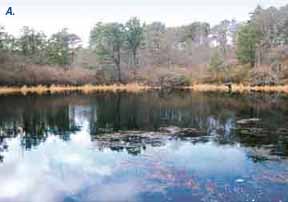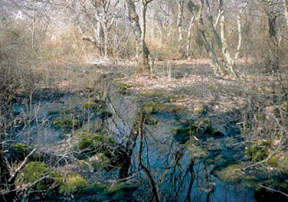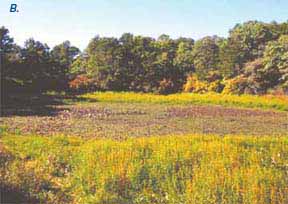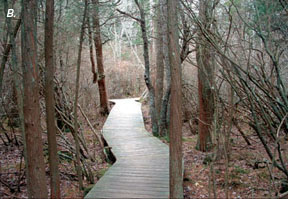Ground-Water Flow and its Effect on Ecology
In addition to being the only source of drinking water for the communities of Lower Cape Cod, ground water is also the primary source of freshwater for kettle-hole ponds, inland wetlands, vernal pools, streams, and coastal waters. These water bodies support much of the biodiversity found throughout the CCNS. The amount of and changes in ground-water discharge over time are essential in maintaining the freshwater and estuarine habitats throughout the CCNS.
Kettle-Hole Ponds
Because of the connection between kettle-hole ponds and the aquifer system, ground water discharges from the aquifer into the ponds primarily close to the shore, through the often highly vegetated zone along the shoreline. The shoreline plant and animal communities, often including rare species, are especially adapted to tolerate seasonal flooding, and depend on naturally high water levels to prevent displacement by less flood-tolerant species (Sorrie, 1994).
The continual refreshing of pond water with ground water reduces the effects of natural salts, such as sea spray, and pollutants, such as from domestic wastewater systems adjacent to the ponds. This flushing process maintains the naturally dilute, clear, and slightly acidic water quality found in the kettle-hole ponds throughout the CCNS.
Inland Wetlands
Inland wetlands, such as shrub and tree swamps and vernal pools, are similar to kettle-hole ponds in that they form in low-lying areas and rely on ground-water discharge as their primary source of freshwater. Seasonally flooded wetlands, such as vernal pools, typically contain water in winter and early spring, when the water table is high and low-lying areas are temporarily flooded; they regularly are dry in mid-summer (fig. 7). This regime of periodic flooding and drying creates habitat for a diverse and distinct group of plants, and particularly, vernal-pool animals, including mole salamanders, wood frogs, and many invertebrates, which could not survive or reproduce successfully in the presence of permanent-pond predators, especially fish (Colburn, 2004).
Natural ground-water levels also sustain red maple and Atlantic white cedar swamps, which have their own distinct biotic communities (fig. 8). These wetlands provide important sources of water to wildlife species, such as box turtles, that otherwise inhabit dry upland landscapes during the summer.
 |
 |
 |
 |
| Figure 7. Vernal pools on Lower Cape Cod are seasonally flooded wetlands that typically contain water in the winter and early spring when the water table is(A) high and are regularly dry in the summer and early fall when the water table is (B) low. This regime of periodic flooding and drying is vital for the life cycles of the diverse plant and animal life that inhabit these areas. Image enlarged |
Figure 8. The inland red maple (A) and white cedar (B) swamps throughout Lower Cape Cod depend upon the natural fluctuations in ground-water levels to support their distinct biotic communities. Image enlarged |
Streams
On Lower Cape Cod, freshwater streams are at the head of small estuaries, with the largest streams being the Herring River in Wellfleet and the Pamet River in Truro (fig. 1). These streams supply freshwater to coastal waters and provide the necessary pathway between the coast and the kettle-hole ponds for migratory fish like the anadromous blue-back herring and alewife, which spawn in the kettle-hole ponds; and for catadromous American eels, which mature in the upper estuary and kettle ponds but spawn in the ocean. Ground-water discharge through the streambed is the primary source of freshwater for these streams. Similar to ponds and wetlands, streams flow in low-lying areas where land surface intersects the water table. Therefore, the amount of flow in these streams is directly related to the altitude of the water table, and small changes in the altitude of the water table can cause large changes in streamflow, which could impede fish migration.
Coastal Waters
The coastal waters, including coastal marshes, that surround Lower Cape Cod are the ultimate discharge areas for freshwater from the ground-water-flow system (Walter and others, 2004). Freshwater enters the coastal waters as either streamflow or as direct ground-water discharge from the aquifer through the coastal seabed. About two-thirds of the 68 Mgal/d of freshwater discharging to the coast is direct ground-water discharge, and the remainder enters coastal waters as surface water from streams (fig. 6). Freshwater discharge to the coast is essential for maintaining the natural range of salinity in coastal waters and salt marshes, which sustains a diversity of shellfish and finfish habitats in the near-shore areas that surround Cape Cod.
